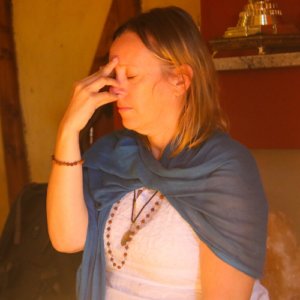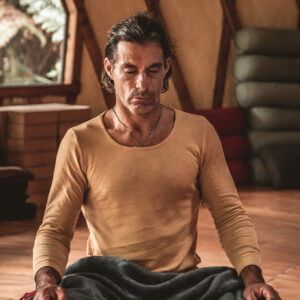Breath – A Journey from Unconscious to Conscious By Swami Karma Karuna
From birth until death, we breathe continuously. If the breath stops for more than a few minutes, then Hari Om Tat Sat, see you later to the physical body! Although, we are mostly not aware of the breath, the way we breathe influences the physical body, mental states, emotions and our health at all the levels. The breath is unique, because unlike other autonomic physiological functions, there is the ability to become conscious of a normally unconscious process. We can alter, lengthen and manipulate the breath, thereby opening up the door to managing our own health, energy levels and mental states. According to Yogis the ultimate purpose of the yogic breathing (pranayama) practices is self-realisation.
The word pranayama is comprised of two roots: prana plus ayama. It is often translated as “breath control” however, ‘Prana’ means “vital energy” or “life force.” ‘Ayama’ is defined as ”extension” or “expansion.”
Therefore, the word ‘pranayama’ actually means “extension and expansion of prana.” The practices taught in general yoga classes are preliminary practices to help one expand the lung capacity, breath awareness and the ability to direct it better. By learning the preliminary practices, one can improve the mental and physical health greatly and gradually have the experience of pranayama.
The yogis say that the quality of our breath reflects the quality and length of our lives. Breathing is a natural process; its normal rhythm is 15 rounds per minute, which correlates to 75 or 80 years of life. Ten rounds per minute lengthens life to about 100 years. This can be seen in nature by the life span of animals in comparison to their breath rates. For example, dogs breathe quickly and live for only about 12 years whereas tortoises breathe very slowly and live for more than 100 years. The norm today in the fast paced world is quick, shallow breathing, which is the cause of ageing and many other imbalances.

In normal unconscious breathing, only half a litre (500mls) of air is moved in and out of the lungs, therefore only a small amount of air is exchanged, as compared to the total capacity of the lungs. This means that on a regular basis, we are only getting a small amount of oxygen and carbon dioxide exchange, therefore not properly feeding our brains and bodies with fresh oxygen, which is vital to life and health. Excess carbon dioxide and lack of oxygen in the body are responsible for many health issues.
However, when yogic breathing is utilized, there is the capacity to take in up to 5 litres of air, thereby enhancing expansion of the lungs and supporting healthy body functions. The deeper breath expands the lungs, so that more alveolar membrane becomes available for gas exchange, expelling more toxins from the body and increasing the capacity for fresh oxygen to feed it.
The quality of the breath is also intimately connected to the mental and emotional states that we experience on a daily basis, as can be seen by how the breath changes with different states of mind. Swami Niranjanananda describes this relationship.
“Irregular respiration usually means tension. In anxiety the breath is shallow and rapid, in anger short and forceful, in grief arrhythmic and gasping, and in depression, sighing. Irregular breathing is also associated with neuroses and disturbed mental states. On the other hand, slow rhythmic breathing is observed to create feelings of relaxation, alpha brain waves and reduced muscle tension”
One can see that in emotional or mentally imbalanced states, the breath becomes irregular, which in turn has an affect on all the different systems of the body, such as the heart rate, the release of certain hormones, the digestive system etc. When there is prolonged alteration of the breath, as is chronic in this day and age, due to over stimulation and stressful lifestyles, there are serious ramifications for the health. Alternatively, during meditation and calm states of mind, the breath becomes rhythmic and deep, igniting a positive affect on the body systems for optimal function.
Most imbalanced states of mind and emotion arise from unconscious and sub-conscious tensions, fears and patterns. So, although one may wish to stay calm in a stressful situation, the reaction or emotional responses often happen before they can be stopped. And once in the emotional state, the irregular breath pattern and state of mind get caught in a negative feedback loop with the breath feeding the imbalanced state of mind and vise versa.

However, although the breath is part of the autonomic nervous system, so will immediately reflect a state of mind without conscious awareness; it is ALSO within our conscious control, which is what makes it so important! No other function of the autonomic nervous system can be controlled by conscious human activity. By knowing how to alter the breath, we can control the physiological responses, emotions and the mind. By means of conscious breathing, other functions of the body may also be influenced, such as heart rate, blood pressure, digestion, excretion and absorption. When the breath is slower for example, the heart rate slows down, the digestive system operates better etc.
Unconscious breathing originates in the medulla oblongata, which is known as the primitive area of the brain associated with instinctual actions, whereas conscious control of the breath seems to by-pass the primitive brain and is linked to the more evolved area of the brain in the cerebral cortex. By simply cultivating breath awareness, the more evolved areas of the brain are stimulated providing one of the most effective ways to reduce tension in the mind.
During pranayama practice, one may experience subconscious images arising in the mind. This is beneficial for the practitioner, as it is the clearing out of samskaras or the mental impressions, which shape how we experience the world. The samskaras are held in the sub-conscious and unconscious layers of the mind. As relaxation occurs through the breathing practices, the fears and complexes, which normally block the physical, energy and mental bodies, have a chance to release. It is the process of conscious elimination of subconscious tensions.
Beyond the benefits that conscious breathing provides for the physical and mental layers of the body, working with the breath further develops an awareness of prana or vital energy. As the breath becomes a more conscious process, there is the ability to consciously alter the prana, which is often depleted, blocked or imbalanced. If there is stiffness in an area, it indicates blocked prana. If one feels tired, the prana is either blocked or depleted. If there is over-excitement or anxiety, there is a pranic over stimulation, which later leads to depletion. Working with the breath on a regular basis consciously develops a depth of self-understanding and the ability to choose particular practices to influence the body or mind as needed at any given time.
If one can control mental and pranic states, access unconscious material and control normally autonomic functions through breath awareness, then obvious health benefits would also be gained in many areas. Once the mind has been stilled and the prana flows freely, the gates to the evolution of consciousness open, leading the aspirant into higher dimensions of spiritual experience.
Ultimately, the aim of pranayama is full awakening of the brain and the experience of the higher dimensions. Modern science states that there are ten areas of the brain and at our present stage of evolution, we are only using one of these areas!!!!! To use the other 90% involves ignition and distribution of prana to the dormant areas of the brain, in order to awaken to the full potential inherent in all human beings. This is the final purpose of pranayama practices, although there are many health and lifestyle benefits that can be acquired along the way.

Swami Karma Karuna Saraswati is an engaging, intuitive yoga and meditation teacher, inspirational speaker, writer and IAYT Certified Yoga Therapist with 30 years of experience in the yoga field including significant training in Nepal and India and ongoing training in the ashram with her teachers.
She is also certified by Yoga Alliance and is a senior teacher of Yoga Australia/New Zealand. A Bachelor of Arts in Interpersonal Communications with a minor in Psychology determined an early interest in working with groups and individuals. Swami Karma Karuna specialises in a range of areas such as Yoga Nidra, Restorative Yoga, Prana, Chakras, Yoga Psychology and Women’s Health.
She is also a co-founder and director of Anahata Yoga Retreat, New Zealand and travels throughout the world, leading workshops, training yoga teachers, presenting at international events, guiding spiritual sadhana retreats and offering therapeutic one to one yoga sessions.
Swami Karma Karuna is passionate about sharing an authentic and down to earth approach, weaving together the ancient practices with a touch of psychology and brain science aimed at motivating people to live their yoga here and now. Several guided practice MP3 tracks including Hatha Yoga classes, Yoga Nidra and Meditation techniques are available through Anahata Yoga Retreat web-site and articles on a variety of subjects can be read in the Australian Yoga Life Magazine.
